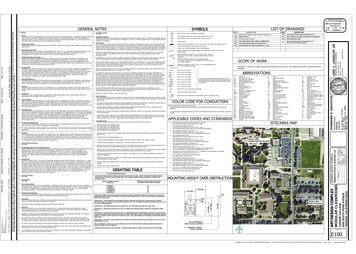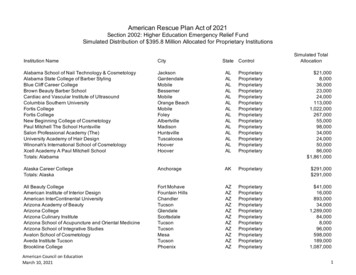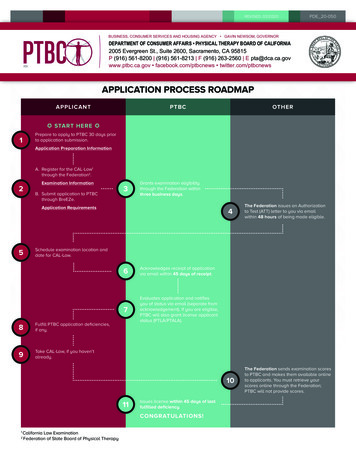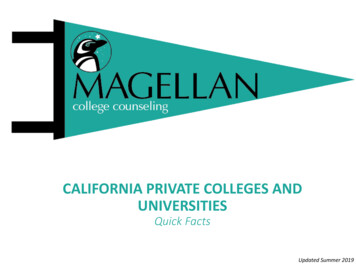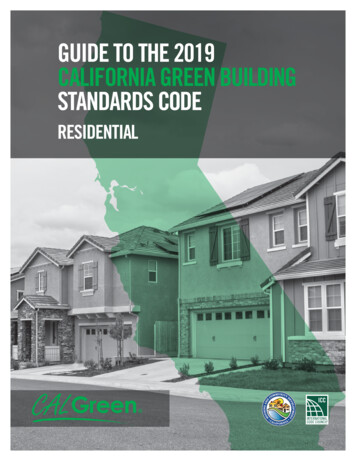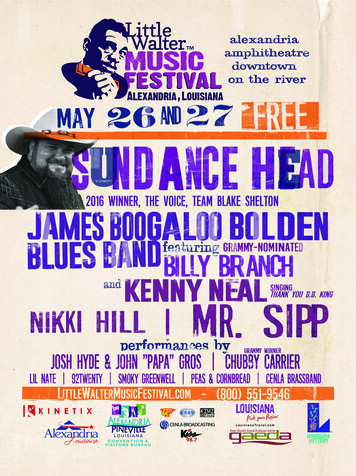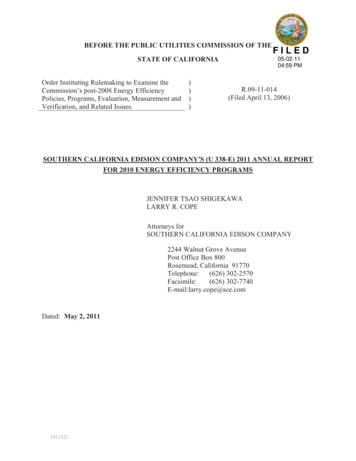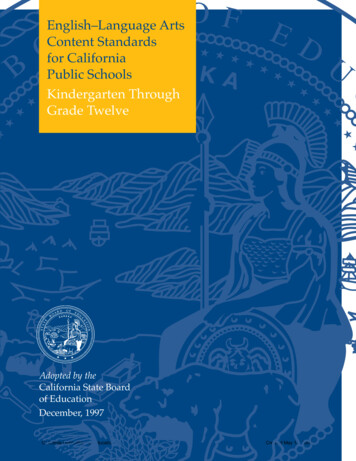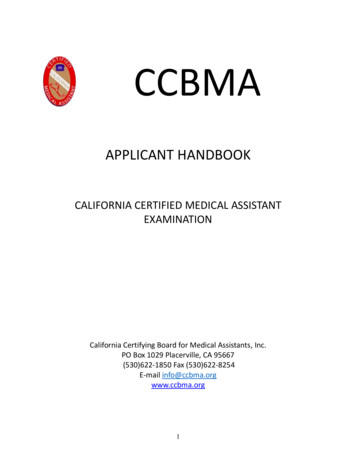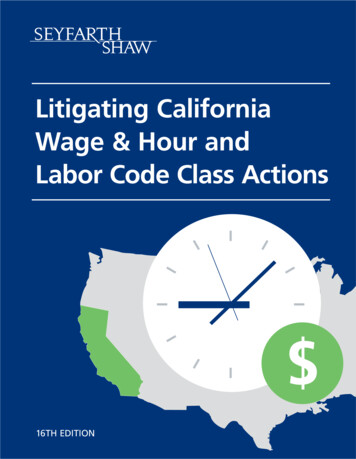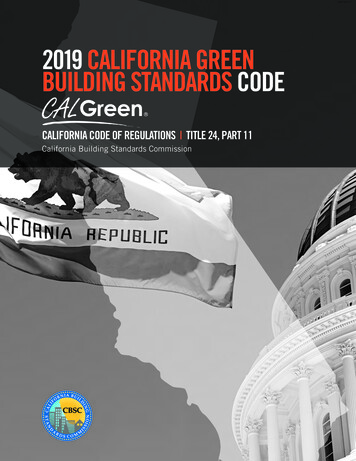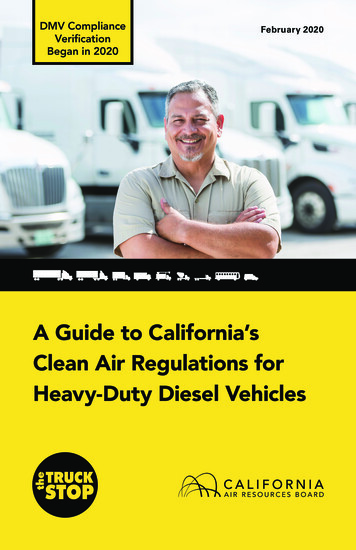
Transcription
DMV ComplianceVerificationBegan in 2020February 2020A Guide to California’sClean Air Regulations forHeavy-Duty Diesel Vehicles
Gear Up, Breathe EasyCARB is actively enforcing heavy-duty diesel vehicle regulations insupport of California’s clean air goals. Enforcement of clean dieselvehicle rules also provides a level playing field for those who havealready done their part and are in compliance.This booklet provides basic information and resources to help take theguesswork out of California’s clean truck and bus requirements. If yourvehicle does not meet state clean air laws, you could be subject tofines or temporarily lose the ability to operate in California.DisclaimerWhile this booklet is intended to assist vehicle owners with theircompliance efforts, it is the sole responsibility of fleets to ensurecompliance with all applicable regulations.MORE INFORMATIONVisit CARB’s comprehensive website for more detailed informationregarding diesel vehicles and compliance options at arb.ca.gov/truckstopPara obtener más informacíon en español, por favor a.gov1-866-6DIESEL (1-866-634-3735)
ContentsWhat diesel rules apply to you?3Trucks & Buses4Truck & Bus Regulation Compliance Options5DMV Compliance Verification Begins in 20206Drayage Trucks7Transportation Refrigeration Units8Tractors & Box-Type Trailers9Other Diesel Programs10Diesel Particulate Filter Care & Maintenance11-12Funding Assistance13Quick Tips14
What diesel rules apply to you?Check all diesel rules that apply to you.Does your vehicle have a Gross Vehicle Weight Rating (GVWR)of 14,000 lbs.?See Trucks and Buses (private and federal fleets): page 4Other rules may apply, see below.Is your fleet publicly owned, a solid waste collection vehicle,or a transit agency or utility?See Public Fleets and Others: page 10Do you visit ports or intermodal rail yards?See Drayage Trucks: page 7Do you own or operate a reefer (transport refrigeration unit)?See Transport Refrigeration Units: page 8Do you own or pull 53-foot or longer box-type trailers?See Tractors and Box-Type Trailers: page 9Do you own a vehicle with a GVWR of 6,000 lbs.?See Idling Limits: page 10See Emission Control Labels: page 10See Heavy-Duty Vehicle Inspection Program: page 10See Periodic Smoke Inspection Program: page 103
Truck & Bus RegulationOn-road diesel vehicles with a GVWR that is 14,001 lbs. mustreduce exhaust emissions by meeting particulate matter (PM) filterrequirements and upgrading to newer engines. Vehicles with 2010engine model year (EMY) or newer are fully compliant.Heavier Vehicles with a GVWR greater than 26,000 lbs. must upgradeas shown in the table. Reporting is optional when exclusively using theEngine Model Year schedule for heavier vehicles below.EMY Schedule for Heavier Vehicles ( 26,000 lbs. GVWR)EMYLevel 3 PM Filter2010 EMY byPre-1994Not requiredJanuary 1, 20151994-1995Not requiredJanuary 1, 20161996-1999January 1, 2012January 1, 20202000-2004January 1, 2013January 1, 20212005 or newerJanuary 1, 2014January 1, 20222007-2009If already equippedJanuary 1, 2023Lighter Vehicles with a GVWRbetween 14,001 and 26,000lbs. need to be upgraded with2010 or newer EMY. Checkthe table to determine yourreplacement date. Oldervehicles may be upgraded tonewer used equipment thatis still in compliance with theschedule. No retrofit PM filteror reporting is required forlighter vehicles.For more information call1-866-6DIESEL (866-634-3735)or visit arb.ca.gov/truckstopEMY Schedule for Lighter Vehicles(14,001-26,000 lbs. GVWR)EMY2010 EMY by1995 and olderJanuary 1, 20151996January 1, 20161997January 1, 20171998January 1, 20181999January 1, 20192003 and olderJanuary 1, 20202004-2006January 1, 20212007-2009January 1, 2023Other compliance options may help you comply with the regulation(see page 5). Reporting is required by January 31 of the complianceyear to claim any available options.4
Compliance OptionsRequires reporting in CARB's TRUCRS systemListed below are the remaining compliance options available for 2019and future compliance years. If you do not qualify for these options, youmust follow the Engine Model Year (EMY) schedule found on page 4.Low-Use ExemptionThe mileage limit is 1,000 miles per year in California. If you havevehicles designed to power other equipment while stationary, the limitis 100 hours per year in California.Low Mileage Construction Truck OptionEligible vehicles with a particulate matter filter that don't meet theEMY schedule may operate up to 15,000 miles per year, and up to20,000 miles for dump trucks. Lighter vehicles can no longer claim thisflexibility option. No longer available for opt-in.Agricultural Vehicle Extension for Replacement VehiclesAgricultural vehicles that reported for this flexibility option cannotoperate more than 10,000 miles per year until January 1, 2023. Nolonger available for opt-in.NOX Exempt Area ExtensionThe counties that were added to the list of NOX Exempt Areas underthe 2014 amendments have been removed, and a PM filter mustalready be installed to claim the NOX Exempt Area Extension.Retrofit by 2014 and Additional Time for Engine ReplacementLighter vehicles with pre-2000 model year engines and heavier vehicleswith pre-1996 model year engines that were retrofit by January 1,2014 and reported to use this compliance option have until January 1,2020 to delay engine replacement. If all the vehicles in your fleet hada diesel particulate filter by January 1, 2014, they may operate untilJanuary 1, 2023. No longer available for opt-in.Options No Longer Available Heavy Cranes Phase-In Option. The twenty-five percent annual vehicle upgrade limit. Cattle livestock trucks are no longer eligible for Specialty Ag Extension.Note that the 2017 Lawson Lawsuit impacted many of the previouslyexisting options and deadlines, and many are no longer available orhave expired.5
DMV Compliance VerificationBegan in 2020A new enforcement tool ensure that vehicles subject to CARB’s Truckand Bus Regulation must meet the health-based requirements of thatrule prior to obtaining registration through the California DMV. As ofJanuary 1, 2020, the DMV cannot register any vehicle that does notmeet the requirements of the Truck and Bus Regulation.2020 DMV Registration RequirementsYou must be in compliance with the Truck and Bus Regulation in oneof the following ways in order to register your vehicle with the DMV: The vehicle is using an allowable compliance optionand is reported into the TRUCRS reporting system The vehicle is compliant with the EngineModel Year Schedule (see page 4) The vehicle is equipped with a 2010 or newer model yearengine (usually a 2011 or newer model year vehicle) ORis repowered with 2010 or newer model year engineCurrently out of compliance?CARB can issue DMV registration blocks now if your vehicle does notmeet air quality requirements.6
Drayage TrucksDiesel-fueled trucks transporting cargo destined for or coming fromCalifornia’s ports and intermodal rail yards (including bobtails andtransporting chassis) must be registered in the statewide Drayage TruckRegistry prior to entry. Drayage fleets must comply with requirementsby operating only vehicles with 2007 MY engines or newer.Drayage Compliance Schedule (GVWR 26,001 lbs. or more)Truck Engine Model YearEmission Requirements2006 and olderNot allowed2007-2009Compliant through 20222010 and newerFully compliantBy January 1, 2023, all class 7 and 8diesel-fueled drayage trucks musthave 2010 or newer engines. Truckswith 2010 or newer engines are fullycompliant with both the Truck andBus and Drayage regulations.The exchange of marine or rail cargo(e.g. containers) between compliantand noncompliant drayage trucks isnot allowed anywhere in California.Note: If you are considered exempt from the Drayage TruckRegulation, you are currently subject to the Truck and Bus Regulation.Drayage Truck Regulation1-888-247-4821 arb.ca.gov/drayagetruck7
Transport Refrigeration Units (Reefers)All transport refrigeration units(TRU) and TRU generator sets thatoperate in California must meet thein-use performance standards (seecompliance table below).Every California-based TRU and TRUgenerator set must be registeredin Air Resources Board EquipmentRegistration (ARBER) and be labeledwith a CARB Identification Number.All terminals that are located in California where TRUs are based mustsubmit operator reports to CARB at arber.arb.ca.gov.TRU and TRU Generator Set Compliance ScheduleEngine ModelYearLow-Emission TRU(50% PM Reduction)Ultra-Low-Emission TRU(85% PM Reduction)2001 or olderDecember 31, 2009December 31, 20152002December 31, 2009December 31, 20162003December 31, 2010December 31, 20172004 ( 25 hp)December 31, 2011December 31, 20182004 ( 25 hp)Not ApplicableDecember 31, 20112005 and newerNot ApplicableDecember 31st of the modelyear plus 7 yearsFleets may comply by using Alternative Technologies (e.g. hybridelectric TRUs or TRUs equipped with electric standby) or retrofittingwith a verified diesel particulate filter. For guidance on using electricstandby and hybrid-electric TRUs as an Alternative Technologycompliance option, visit andby ets.pdf.All businesses that hire carriers (e.g. brokers, shippers and receivers)must only use carriers that supply compliant TRUs.Transport Refrigeration Unit Regulation Helpline1-888-TRU-ATCM (1-888-878-2826) arb.ca.gov/diesel/tru/tru.htm8
Tractors & Box-type TrailersThe Tractor-Trailer Greenhouse Gas Regulation applies to 53-foot orlonger box-type trailers and 2013 MY or older heavy-duty tractors thatpull these trailers.Low-Rolling Resistance Tire Requirements*2013 andolder MYTractorsTrailersRequiredRequired2014 and N/Anewer MYRequired* Must be SmartWay -certified.Tractor RequirementsAll 2011 through 2013 MY sleeper-cabtractors must be SmartWay designatedmodels. 2014 MY or newer tractors arecovered by a federal regulation and areexempt from this rule.Trailer Aerodynamic RequirementsAll trailers must be either SmartWay certified or aerodynamically retrofittedto a minimum standard.Delays and ExemptionsCertain trucks subject to the Transportation Refrigeration Unit (TRU)rule can phase in tire and aerodynamic requirements from 2018 to2020. This only applies to TRUs with 2003 to 2009 MY reefer trailersequipped with 2003 or newer TRU engines.Fleets must register to take advantage of short haul, local haul orstorage trailer exemptions, and to apply for temporary use passes.For more information, visit arb.ca.gov/tractortrailer ghgFor a listing of SmartWay -certified technologies, visitarb.ca.gov/cc/hdghg/technologies.htm9
Other Diesel ProgramsCARB continues to actively enforce long-standing requirementsfor diesel vehicles including:Idling LimitsIdling Limits restrict diesel vehicles fromidling more than five minutes. Idling in schoolzones is not allowed, with limited exceptions.arb.ca.gov/noidleEmission Control LabelsEmission Control Labels must be affixed toengines of all commercial heavy-duty dieselvehicles, and must be legible as proof theengine, at minimum, meets U.S. federalemissions standards for the engine model year.Periodic Smoke Inspection ProgramThe Periodic Smoke Inspection Programrequires owners of California-based fleets oftwo or more diesel vehicles to perform annualsmoke opacity tests and to keep recordsfor at least two years for each vehicle. Therequirement does not apply to cars or trucksthat must undergo a Smog Check.Heavy-Duty Vehicle Inspection ProgramThe Heavy-Duty Vehicle Inspection Programuses random roadside inspections to verifythat diesel engines do not smoke excessivelyand are tamper-free.arb.ca.gov/enf/hdvip/hdvip.htmPublic Fleets and OthersVehicles with a GVWR of 14,001 lbs. that areowned by state and local government fleets,private utilities, and solid waste collectionvehicles, must already have particulate matter(PM) filters (retrofit or originally equipped).10
Soot Filter: Buyer BewareUse only CARB-verified soot filters!Selecting and installing the right CARB-verified diesel particulate filter(DPF), also known as a soot filter, for your truck takes time. If your filteris not installed by January 1st of the applicable compliance year, orordered four months prior to the deadline, then you may be in violation.Visit arb.ca.gov/truckstop and select “Engine Filters” for details.Be aware, filters must be verified for use on your vehicle. Used filtersare not compliant and may damage your engine.Compliance options that utilize new filter installation are limited.Therefore, installation of a filter without being aware of the availableoptions may result in a non-compliant vehicle. Make sure youunderstand your compliance options.The emissions performance of every DPF technology has been verifiedby CARB through rigorous testing. Keep in mind that a DPF is not a “fitand forget” device. Protect your DPF and engine by paying attention toa few simple but important maintenance requirements.Resolving DPF-Related ProblemsWhile a DPF undergoes a rigorous verification process prior to sale,occasional problems may arise. Use the following three-step protocolto resolve DPF-related performance or reliability problems: Contact your installer (most problems are resolved in this manner) Contact the device manufacturer (if the installercannot resolve your complaint) Contact CARB at 866-6DIESEL or 8666DIESEL@arb.ca.gov(if the installer or manufacturer cannot resolve your complaint).11
Diesel Particulate FilterCare & MaintenanceVehicle Maintenance is CriticalTop-notch vehicle engine maintenance is required. Remember to checkfuel injectors, air filters, turbo chargers, fuel filter, fuel, coolant andlube oil. Failure to maintain the engine can void the DPF warranty!Don’t Ignore the DPF Monitoring SystemThe cab of the truck features a monitoring system for the DPF thatincludes several indicator lights that give important feedback onDPF operation. The operator must understand and observe the DPFindicator lights on a regular basis and respond accordingly.Maintain the Proper Engine Duty CycleThe duty cycle is the daily pattern of engine use. If the duty cycle ofa truck is changed, it may affect how the filter works, and can leadto plugging. Notify your installer if you change the way you use yourvehicle and be aware that it may affect the way your filter functions.Understand Your DPF’s Regeneration SystemThe soot collected by the DPF must eventually be removed to keepthe filter from clogging. The process of burning the soot in the filter iscalled regeneration and is done using high temperatures for a specifiedamount of time. Your truck is equipped with either a passive systemthat cleans the DPF automatically or an active system that may workautomatically or require driver intervention to start a regeneration cycle.Handle the Filter with CareDPFs are commonly made of ceramic, so do not bang or tap on yourfilter. A cracked or damaged filter may not be compliant with the Truckand Bus Regulation and could be a citable violation.DPF Cleaning BasicsThe DPF is a maintenance item. It must be removed and cleanedperiodically to get rid of accumulated noncombustible ash fromthe filter. Ash removal is separate from regeneration. Only use filtercleaning procedures approved by the DPF manufacturer.A guide to operating your DPF is available at arb.ca.gov/truckstop orby contacting (866) 6DIESEL or 8666DIESEL@arb.ca.gov.12
Funding AssistanceGrant funding is very limited but may be available to help fleetsand individuals comply with California regulations earlier thanis required.Funding is available for vehicle replacements, retrofits, andzero-emission technologies. Please contact the local air district whereyou are based to determine if you are eligible for fundingor if an opportunity may become available in the future. One exampleis the Funding Agricultural Replacement Measures for EmissionReductions (FARMER) Program, which provides funding through localair districts for agricultural harvesting equipment, heavy-duty trucks,agricultural pump engines, tractors, and other equipment used inagricultural operations.CARB’s loan assistance program (PLACE) helps small businesses withvehicles that operate at least 50 percent of the time in California. Theprogram connects truckers to participating lenders to help purchasetrucks, PM filters, aerodynamic retrofits or low-rolling resistance tires.More information is available at arb.ca.gov/loanassistEquipment owners are encouraged to apply as early as possible tomaximize potential funding options. See the Financial Assistancesection on the TruckStop website for more funding information.13
Quick Tips All fleet owners who use compliance options must reportinformation about all eligible vehicles in the Californiafleet into the Truck Regulation Up-load, Compliance, andReporting System (TRUCRS). The reporting period is openfrom January 1st to January 31st of the compliance year. Records must be kept and provided upon request to demonstratecompliance with flexibility options claimed in the reporting system. The Truck and Bus Regulation is based on the model yearof the engine. Generally, the model year of an engine isone year older than the vehicle model year. For example, a2007 truck is likely to have a 2006 engine model year. Vehicles that operate less than 1,000 annual miles withinCalifornia can qualify for the low-mileage usage exemption.Odometer readings must be reported annually to CARB. Selecting and installing a diesel particulate filter (DPF),also known as a soot filter, for your truck takes time.Make sure to use only CARB-verified soot filters. The gross vehicle weight rating (GVWR) is assigned by the vehiclemanufacturer and represents the maximum weight of the vehicleand what it can carry when fully loaded. Check the driver’s doorjam for the GVWR label. The GVWR is not the same as the unladenweight, gross combined weight rating, or registered weight rating. The Engine (Emission) Family Name (EFN) can be found on theemission control label located on the engine. The EFNis typically 10 to 12 characters, however very old enginesmay have an EFN only a few characters long. Be aware that tampering with your engine odometercan put you out of compliance with engine certificationrequirements and the Truck and Bus Regulation.14
Not sure if your diesel truck, bus orequipment complies with Californiaair quality regulations?Register & ReportUse the TruckStop to find out what youneed to do to comply and avoid penalties.TrainingFAQsSign up for freelive trainingclasses.VideosSee questions andanswers from our dieselhotline generated bytruckers like you.DPFView short videosthat explain dieselrequirements andreporting systems.FundingFinancial assistancemay be available tohelp clean up yourtrucks, buses andequipment.Find out about dieselparticulate filters.AnswersVisit the TruckStop atarb.ca.gov/truckstop
engine model year (EMY) or newer are fully compliant. Heavier Vehicles with a GVWR greater than 26,000 lbs. must upgrade as shown in the table. Reporting is optional when exclusively using the Engine Model Year schedule for heavier vehicles below.
